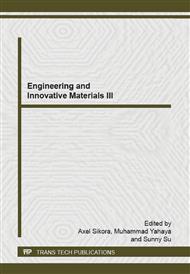p.175
p.180
p.184
p.189
p.193
p.198
p.204
p.209
p.214
Characteristics of Potassium Acetate - Activated Coconut Shell Carbon
Abstract:
There is significant portion of agricultural wastes in the world posing environmental challenge; however, they could be converted into useful products like activated carbon. In this study, coconut shell based carbons were synthesized using chemical activation with potassium acetate (PAAC), potassium hydroxide (PHAC) and physical activation by CO2 (CSAC). The properties of potassium acetate-activated carbon were characterized and the results were compared with the other activation methods. The pyrolysis temperature of 700°C for 2h yielded 32% of char. The BET surface area and pore volume of PAAC are 622m2/g and 0.31cm3/g; while 369m2/g and 0.19cm3/g, and 1354m2/g and 0.61cm3/g were recorded for CSAC and PHAC, respectively. CSAC yielded lower surface area with approximately 88% micropores. On the other hand, PAAC yielded higher surface area with approximately 50% of both micropores and mesopores, whereby this heteroporous property would suffice for a wider range of application. From the Fourier Transform Infrared Spectroscopy analysis, hydroxyls, alkenes, carbonyls and aromatics functional groups were identified with more prominent peaks on the chemically activated porous carbons. From thermogravimetric analysis (TGA), lignin decomposition occurred in a wider temperature range (390-650°C). The properties of PAAC could offer a sustainable means for treatment of toxic waste streams.
Info:
Periodical:
Pages:
193-197
Citation:
Online since:
October 2014
Keywords:
Price:
Сopyright:
© 2014 Trans Tech Publications Ltd. All Rights Reserved
Share:
Citation:


